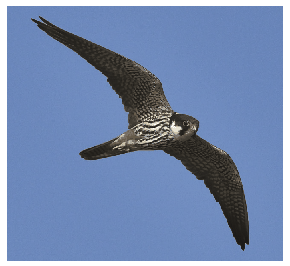 Problem P. 5410. (May 2022)
Problem P. 5410. (May 2022)
P. 5410. The peregrine falcon can travel long distances without flapping its wing. Doing so, its movement has two parts. In the first part, it circles with its wings extended and rises in an upward flowing column of warm air (thermals) at a vertical speed of \(\displaystyle v_1\). In the second part, it leaves the thermal at an angle of \(\displaystyle \alpha\) with respect to the horizontal and glides at a constant speed to the next thermal at a distance of \(\displaystyle L\). The glide speed \(\displaystyle v_2\) is approximately directly proportional to the sine of the angle \(\displaystyle \alpha\) (the direction of glide with the horizontal): \(\displaystyle v_2=k \sin\alpha\), where \(\displaystyle k\) is a known constant.

\(\displaystyle a)\) To what minimum height must a peregrine rise in the thermal so that the time of its rising and gliding motion should be the shortest possible?
\(\displaystyle b)\) At least how much time is needed for the peregrine to move from the bottom of a thermal to the bottom of the next thermal?
\(\displaystyle c)\) Determine the glide angle which belongs to the motion with the optimal flight time.
Data: \(\displaystyle v_1=2~\frac{\mathrm{m}}{\mathrm{s}}\), \(\displaystyle k=10~\frac{\mathrm{m}}{\mathrm{s}}\), \(\displaystyle L=2\) km.
(5 pont)
Deadline expired on June 15, 2022.
Sorry, the solution is available only in Hungarian. Google translation
Megoldás. Ha a vándorsólyom a termikben \(\displaystyle H\) magasra emelkedik, ehhez \(\displaystyle t_1=\frac{H}{v_1}\) időre van szüksége. A következő termik aljáig \(\displaystyle \sqrt{H^2+L^2}\) hosszú úton siklik le, és mivel a sebessége
\(\displaystyle v_2=k\sin\alpha=k {\frac{H}{\sqrt{H^2+L^2}}},\)
a siklás ideje
\(\displaystyle t_2=\frac{\sqrt{H^2+L^2}}{v_2}=\frac{H^2+L^2}{kH}.\)
\(\displaystyle b)\) Az egyik termik aljától a másik termik aljáig a madár
\(\displaystyle T=t_2+t_2=\frac{H}{v_1}+\frac{H^2+L^2}{kH}=\left(\frac{1}{v_1}+\frac{1}{k}\right)H+\frac{L^2}{kH}\)
idő alatt jut el. Alkalmazzuk a számtani és a mértani közepekre vonatkozó egyenlőtlenséget:
\(\displaystyle T(H)\ge 2\sqrt{\frac{L^2}{k}\left(\frac{1}{v_1}+\frac{1}{k}\right)}\approx 980\ {\rm s}\approx 16{,}3\ \text{perc}.\)
\(\displaystyle a)\) A legrövidebb idejű mozgásnál
\(\displaystyle \left(\frac{1}{v_1}+\frac{1}{k}\right)H=\frac{L^2}{kH},\)
vagyis
\(\displaystyle H_\text{min}=\frac{L}{\sqrt{1+\frac{k}{v_1}}}=\frac{2000~\rm m}{\sqrt{6}}\approx 816~\rm m.\)
\(\displaystyle c)\) Az optimális menetidejű mozgás siklási szöge:
\(\displaystyle \alpha=\arctg\frac{H_\text{min}}{L}=22{,}2^\circ.\)
Kiszámíthatjuk még, hogy a vándorsólyom a leírt mozgás során 6,8 percig emelkedik, a siklásának ideje 9,5 perc, a siklás sebessége pedig kb. 3,8 m/s.
Statistics:
26 students sent a solution. 5 points: Beke Bálint, Bencz Benedek, Dóra Márton, Gábriel Tamás, Hauber Henrik, Kertész Balázs, Kovács Kristóf , Mészáros Ádám, Molnár Kristóf, Nemeskéri Dániel, Schmercz Blanka, Seprődi Barnabás Bendegúz, Somlán Gellért, Szabó Márton, Téglás Panna, Toronyi András. 4 points: Csonka Illés, Papp Marcell Imre, Pethő Dorottya, Tárnok Ede , Vágó Botond. 2 points: 1 student. 1 point: 3 students.
Problems in Physics of KöMaL, May 2022
